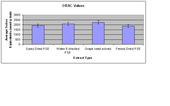Highlight
Utilization of waste products of Virginia agriculture: peanuts and grapes for nutraceutical applications
Achievement/Results
NSF MILES-IGERT Trainees Tameshia Ballard (a recent graduate, December 2008) and Kevin Holland and associate Paul Sarnoski have been working with NSF funded researchers Dr. Kumar Mallikarjunan in the Biological Systems Engineering Department and Dr. Sean O’Keefe in the Food Science and Technology Department at Virginia Tech on developing methods for using peanut byproducts (skins, roots) and grape byproducts (seeds, pomace) to be used as natural antioxidants.
Tameshia Ballard studied the most cost-effective extraction methods that contained the highest number of antioxidant compounds in peanut skin extracts. Her work showed that 38% ethanol extracts resulted in the highest amount of total phenols. She also analyzed the fractions from the peanut skin extracts using high performance liquid chromatography (HPLC) and oxygen radical absorbance capacity (ORAC) to identify the compounds present and the antioxidant capacity of such fractions.
Kevin Holland and Dr. Sean O’Keefe have been investigating the antioxidant activity of peanut skin extracts. They hope that peanut skin extract will replace synthetic antioxidants currently found in food and find an application for an underutilized waste product. They compared the antioxidant activity of peanut skin extract with that of grape seed extract using ORAC. Grape seed extract has been investigated thoroughly and is currently commercialized as an antioxidant additive in food and also as a health supplement. Holland and O’Keefe found that peanut skin extracts prepared various ways and a commercial grape seed extract have similar antioxidant activities as seen in the following graph (PSE= peanut skin extract) (Figure 1). This research proves that peanut skin extract may have commercial value as an antioxidant. Kevin Holland is also studying antioxidants in peanut roots. By finding applications for peanut roots, it may be possible to increase the economic value of these waste materials. The peanut root extracts may also have applications in food products to prolong the shelf life and preserve the taste of foods. Peanut root extracts may also inhibit protein oxidation. Protein oxidation is believed to cause diseases such as Alzheimer’s, atherosclerosis, and has been linked with the aging process. Potent antioxidant fractions from the peanut root extracts may be used as dietary supplements to prevent or slow down disease progression or age-related illnesses.
MILES-IGERT associate Paul Sarnoski will be investigating the ability of polyphenolic compounds in Virginia waste products from peanuts and grapes on inhibition of enzymes related to glycemic control. Antioxidants can assist in achieving oxidative balance for diabetics. Research suggests that the polyphenol polymers can play a direct role in the regulation of diabetes. Water soluble polyphenol extracts containing A-type doubly linked proanthocyanidin oligomers from cinnamon have been found to enhance the activity of insulin. A likely reason for this occurrence is the proanthocyanidin oligomers function as insulin mimetics. Another plausible reason for the polyphenolic compounds ability to have a regulating effect on diabetes may be linked to inhibition of alpha-glucosidase activity. The inhibition of intestinal ?\alpha-glucosidases delays the digestion and absorption of carbohydrates (specifically oligosaccharides), thus suppressing hyperglycemia. Similarly, alpha-amylase catalyzes the hydrolysis of polysaccharides. Polyphenolic compounds have also been shown to inhibit alpha-amylase activity. However, much of the research to date is indecisive which compounds in the extracts are responsible for the inhibition. We hope to isolate the specific compounds responsible for inhibition.
Address Goals
Maximizing value of agricultural output is of vital importance for the success of Virginia farmers. Two important Virginia crops are peanuts and grapes. Viticulture (the study of grapes) has grown rapidly in Virginia over the last 10 years, due to the rapid success of the Virginia wine industry. Virginia peanuts have become increasingly popular since they are larger than the other varieties of peanuts such as Runner and Spanish types and thus have become popular for consumption in whole form. These two crops have potentially high value by-products that have yet to be adequately investigated for viable use. Finding applications of agricultural waste products as potential antioxidants include adding values to waste materials and discovery of natural antioxidants as replacements for synthetic antioxidants in food products. Successful identification of active antioxidant components may result in development of dietary supplements or treatments to combat diseases associated with oxidative stress and aging such as Alzheimer’s disease, atherosclerosis, and diabetes. This research will also allows for training future professors/researchers and industry scientists in a variety of analytical techniques (chromatography, ORAC) and cellular techniques.






